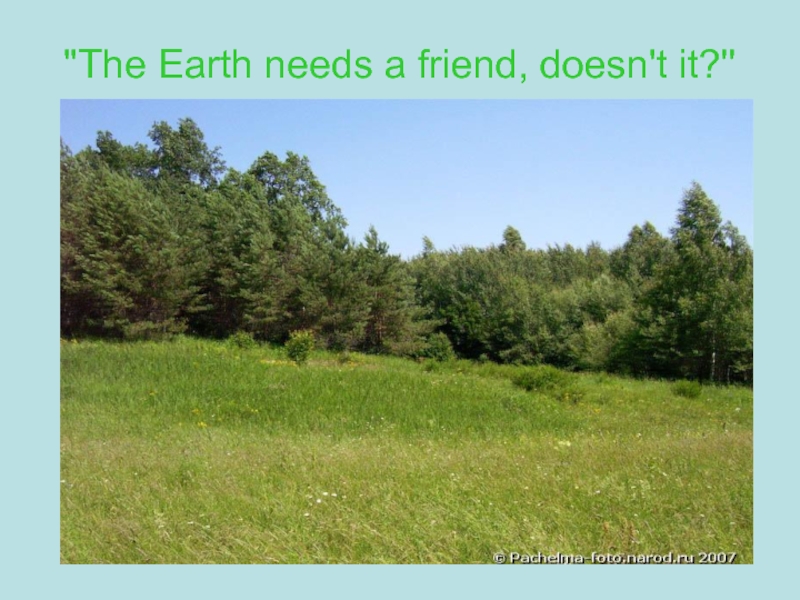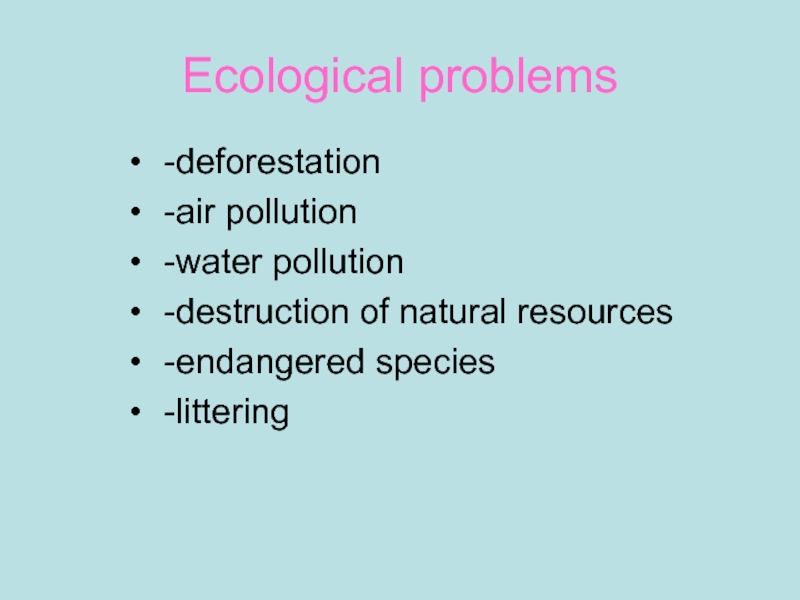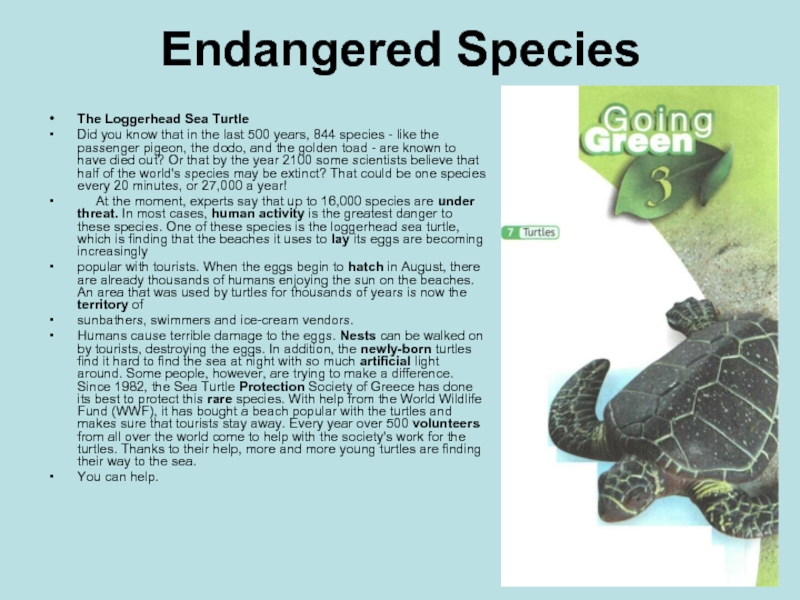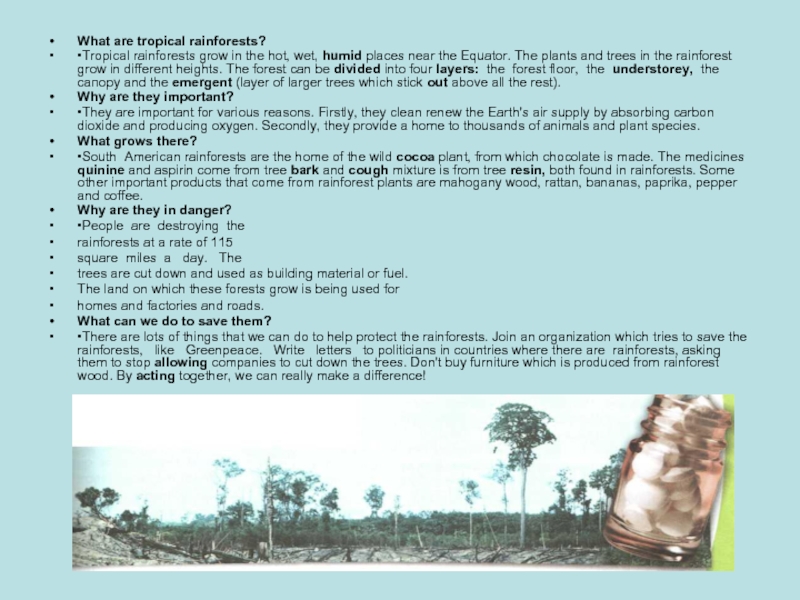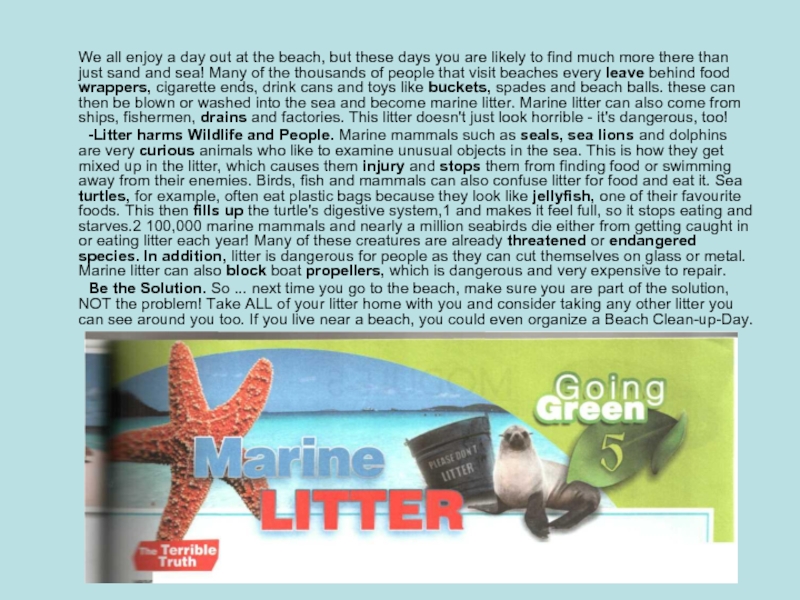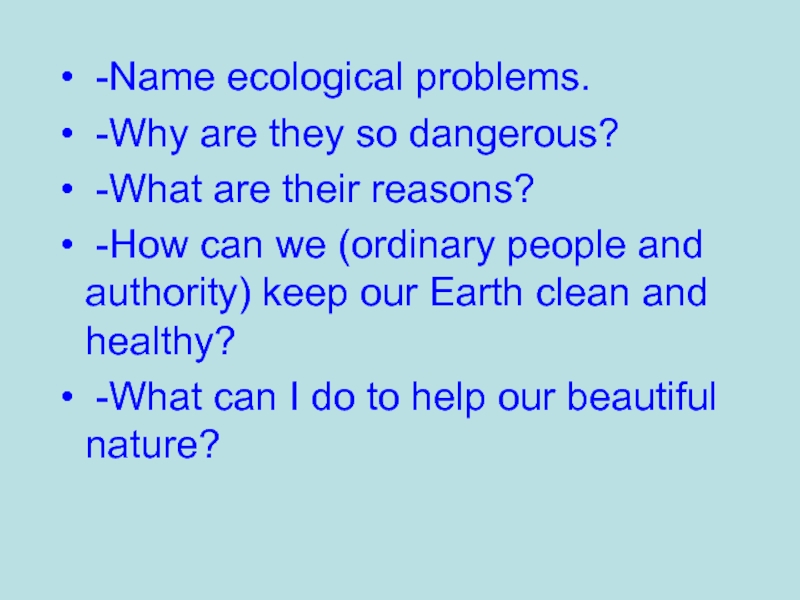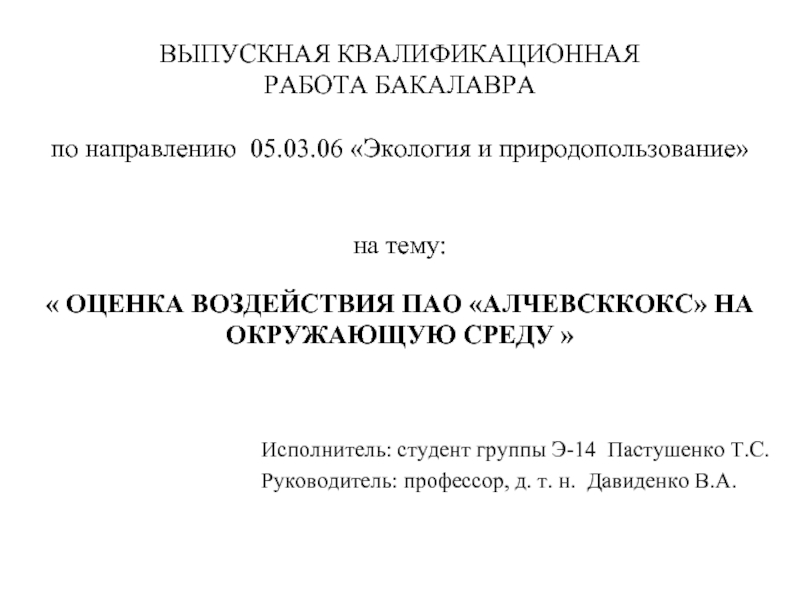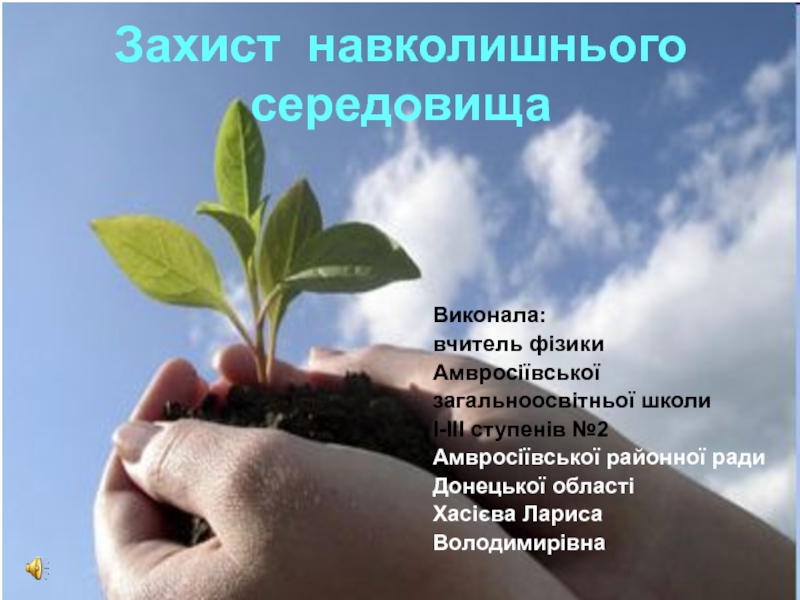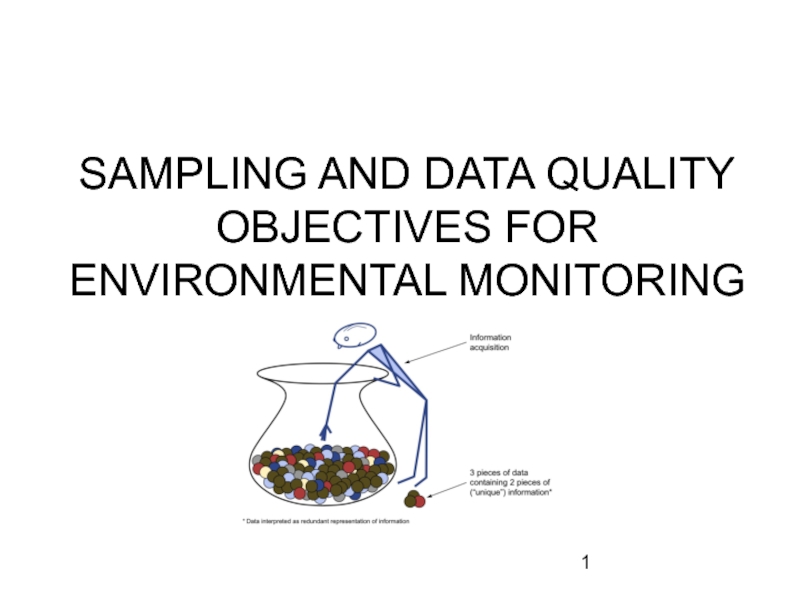- Главная
- Разное
- Дизайн
- Бизнес и предпринимательство
- Аналитика
- Образование
- Развлечения
- Красота и здоровье
- Финансы
- Государство
- Путешествия
- Спорт
- Недвижимость
- Армия
- Графика
- Культурология
- Еда и кулинария
- Лингвистика
- Английский язык
- Астрономия
- Алгебра
- Биология
- География
- Детские презентации
- Информатика
- История
- Литература
- Маркетинг
- Математика
- Медицина
- Менеджмент
- Музыка
- МХК
- Немецкий язык
- ОБЖ
- Обществознание
- Окружающий мир
- Педагогика
- Русский язык
- Технология
- Физика
- Философия
- Химия
- Шаблоны, картинки для презентаций
- Экология
- Экономика
- Юриспруденция
Ecological problems презентация
Содержание
Слайд 2Ecological problems
-deforestation
-air pollution
-water pollution
-destruction of natural resources
-endangered species
-littering
-littering
Слайд 3 -There is no place in nature for extinction. (Licretius, Roman
poet and philosopher).
-A nation that destroys its soil destroys itself. Forests are the lungs of our land, purifying the air and giving fresh strength to our people. (Franklin Roosevelt, American president).
-There's so much pollution in the air now that if it weren't for our lungs, there would be no place to put it all. (Robert Orben, US comedy writer).
-A society is not defined by what it creates, but by what it refuses to destroy. (John Sawhill, US environmentalist).
-Nature provides a free lunch, but only if we control our appetites. (William Ruckelshaus, US environmentalist).
-A nation that destroys its soil destroys itself. Forests are the lungs of our land, purifying the air and giving fresh strength to our people. (Franklin Roosevelt, American president).
-There's so much pollution in the air now that if it weren't for our lungs, there would be no place to put it all. (Robert Orben, US comedy writer).
-A society is not defined by what it creates, but by what it refuses to destroy. (John Sawhill, US environmentalist).
-Nature provides a free lunch, but only if we control our appetites. (William Ruckelshaus, US environmentalist).
Слайд 4Endangered Species
The Loggerhead Sea Turtle
Did you know that in the last
500 years, 844 species - like the passenger pigeon, the dodo, and the golden toad - are known to have died out? Or that by the year 2100 some scientists believe that half of the world's species may be extinct? That could be one species every 20 minutes, or 27,000 a year!
At the moment, experts say that up to 16,000 species are under threat. In most cases, human activity is the greatest danger to these species. One of these species is the loggerhead sea turtle, which is finding that the beaches it uses to lay its eggs are becoming increasingly
popular with tourists. When the eggs begin to hatch in August, there are already thousands of humans enjoying the sun on the beaches. An area that was used by turtles for thousands of years is now the territory of
sunbathers, swimmers and ice-cream vendors.
Humans cause terrible damage to the eggs. Nests can be walked on by tourists, destroying the eggs. In addition, the newly-born turtles find it hard to find the sea at night with so much artificial light around. Some people, however, are trying to make a difference. Since 1982, the Sea Turtle Protection Society of Greece has done its best to protect this rare species. With help from the World Wildlife Fund (WWF), it has bought a beach popular with the turtles and makes sure that tourists stay away. Every year over 500 volunteers from all over the world come to help with the society's work for the turtles. Thanks to their help, more and more young turtles are finding their way to the sea.
You can help.
At the moment, experts say that up to 16,000 species are under threat. In most cases, human activity is the greatest danger to these species. One of these species is the loggerhead sea turtle, which is finding that the beaches it uses to lay its eggs are becoming increasingly
popular with tourists. When the eggs begin to hatch in August, there are already thousands of humans enjoying the sun on the beaches. An area that was used by turtles for thousands of years is now the territory of
sunbathers, swimmers and ice-cream vendors.
Humans cause terrible damage to the eggs. Nests can be walked on by tourists, destroying the eggs. In addition, the newly-born turtles find it hard to find the sea at night with so much artificial light around. Some people, however, are trying to make a difference. Since 1982, the Sea Turtle Protection Society of Greece has done its best to protect this rare species. With help from the World Wildlife Fund (WWF), it has bought a beach popular with the turtles and makes sure that tourists stay away. Every year over 500 volunteers from all over the world come to help with the society's work for the turtles. Thanks to their help, more and more young turtles are finding their way to the sea.
You can help.
Слайд 5What are tropical rainforests?
•Tropical rainforests grow in the hot, wet, humid
places near the Equator. The plants and trees in the rainforest grow in different heights. The forest can be divided into four layers: the forest floor, the understorey, the caпору and the emergent (layer of larger trees which stick out above all the rest).
Why are they important?
•They are important for various reasons. Firstly, they clean renew the Earth's air supply by absorbing carbon dioxide and producing oxygen. Secondly, they provide a home to thousands of animals and plant species.
What grows there?
•South American rainforests are the home of the wild cocoa plant, from which chocolate is made. The medicines quinine and aspirin come from tree bark and cough mixture is from tree resin, both found in rainforests. Some other important products that come from rainforest plants are mahogany wood, rattan, bananas, paprika, pepper and coffee.
Why are they in danger?
•People are destroying the
rainforests at a rate of 115
square miles a day. The
trees are cut down and used as building material or fuel.
The land on which these forests grow is being used for
homes and factories and roads.
What can we do to save them?
•There are lots of things that we can do to help protect the rainforests. Join an organization which tries to save the rainforests, like Greenpeace. Write letters to politicians in countries where there are rainforests, asking them to stop allowing companies to cut down the trees. Don't buy furniture which is produced from rainforest wood. By acting together, we can really make a difference!
Why are they important?
•They are important for various reasons. Firstly, they clean renew the Earth's air supply by absorbing carbon dioxide and producing oxygen. Secondly, they provide a home to thousands of animals and plant species.
What grows there?
•South American rainforests are the home of the wild cocoa plant, from which chocolate is made. The medicines quinine and aspirin come from tree bark and cough mixture is from tree resin, both found in rainforests. Some other important products that come from rainforest plants are mahogany wood, rattan, bananas, paprika, pepper and coffee.
Why are they in danger?
•People are destroying the
rainforests at a rate of 115
square miles a day. The
trees are cut down and used as building material or fuel.
The land on which these forests grow is being used for
homes and factories and roads.
What can we do to save them?
•There are lots of things that we can do to help protect the rainforests. Join an organization which tries to save the rainforests, like Greenpeace. Write letters to politicians in countries where there are rainforests, asking them to stop allowing companies to cut down the trees. Don't buy furniture which is produced from rainforest wood. By acting together, we can really make a difference!
Слайд 6 We all enjoy a day out at the beach, but these
days you are likely to find much more there than just sand and sea! Many of the thousands of people that visit beaches every leave behind food wrappers, cigarette ends, drink cans and toys like buckets, spades and beach balls. these can then be blown or washed into the sea and become marine litter. Marine litter can also come from ships, fishermen, drains and factories. This litter doesn't just look horrible - it's dangerous, too!
-Litter harms Wildlife and People. Marine mammals such as seals, sea lions and dolphins are very curious animals who like to examine unusual objects in the sea. This is how they get mixed up in the litter, which causes them injury and stops them from finding food or swimming away from their enemies. Birds, fish and mammals can also confuse litter for food and eat it. Sea turtles, for example, often eat plastic bags because they look like jellyfish, one of their favourite foods. This then fills up the turtle's digestive system,1 and makes it feel full, so it stops eating and starves.2 100,000 marine mammals and nearly a million seabirds die either from getting caught in or eating litter each year! Many of these creatures are already threatened or endangered species. In addition, litter is dangerous for people as they can cut themselves on glass or metal. Marine litter can also block boat propellers, which is dangerous and very expensive to repair.
Be the Solution. So ... next time you go to the beach, make sure you are part of the solution, NOT the problem! Take ALL of your litter home with you and consider taking any other litter you can see around you too. If you live near a beach, you could even organize a Beach Clean-up-Day.
-Litter harms Wildlife and People. Marine mammals such as seals, sea lions and dolphins are very curious animals who like to examine unusual objects in the sea. This is how they get mixed up in the litter, which causes them injury and stops them from finding food or swimming away from their enemies. Birds, fish and mammals can also confuse litter for food and eat it. Sea turtles, for example, often eat plastic bags because they look like jellyfish, one of their favourite foods. This then fills up the turtle's digestive system,1 and makes it feel full, so it stops eating and starves.2 100,000 marine mammals and nearly a million seabirds die either from getting caught in or eating litter each year! Many of these creatures are already threatened or endangered species. In addition, litter is dangerous for people as they can cut themselves on glass or metal. Marine litter can also block boat propellers, which is dangerous and very expensive to repair.
Be the Solution. So ... next time you go to the beach, make sure you are part of the solution, NOT the problem! Take ALL of your litter home with you and consider taking any other litter you can see around you too. If you live near a beach, you could even organize a Beach Clean-up-Day.
Слайд 7 -Name ecological problems.
-Why are they so dangerous?
-What are
their reasons?
-How can we (ordinary people and authority) keep our Earth clean and healthy?
-What can I do to help our beautiful nature?
-How can we (ordinary people and authority) keep our Earth clean and healthy?
-What can I do to help our beautiful nature?
